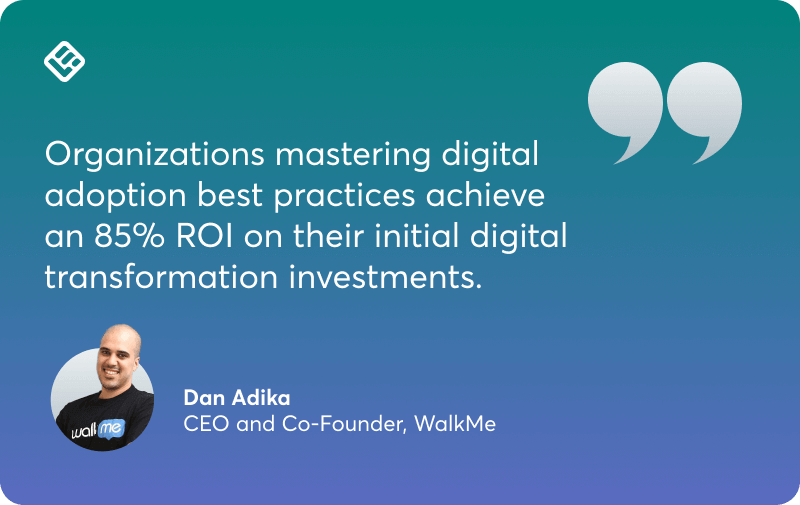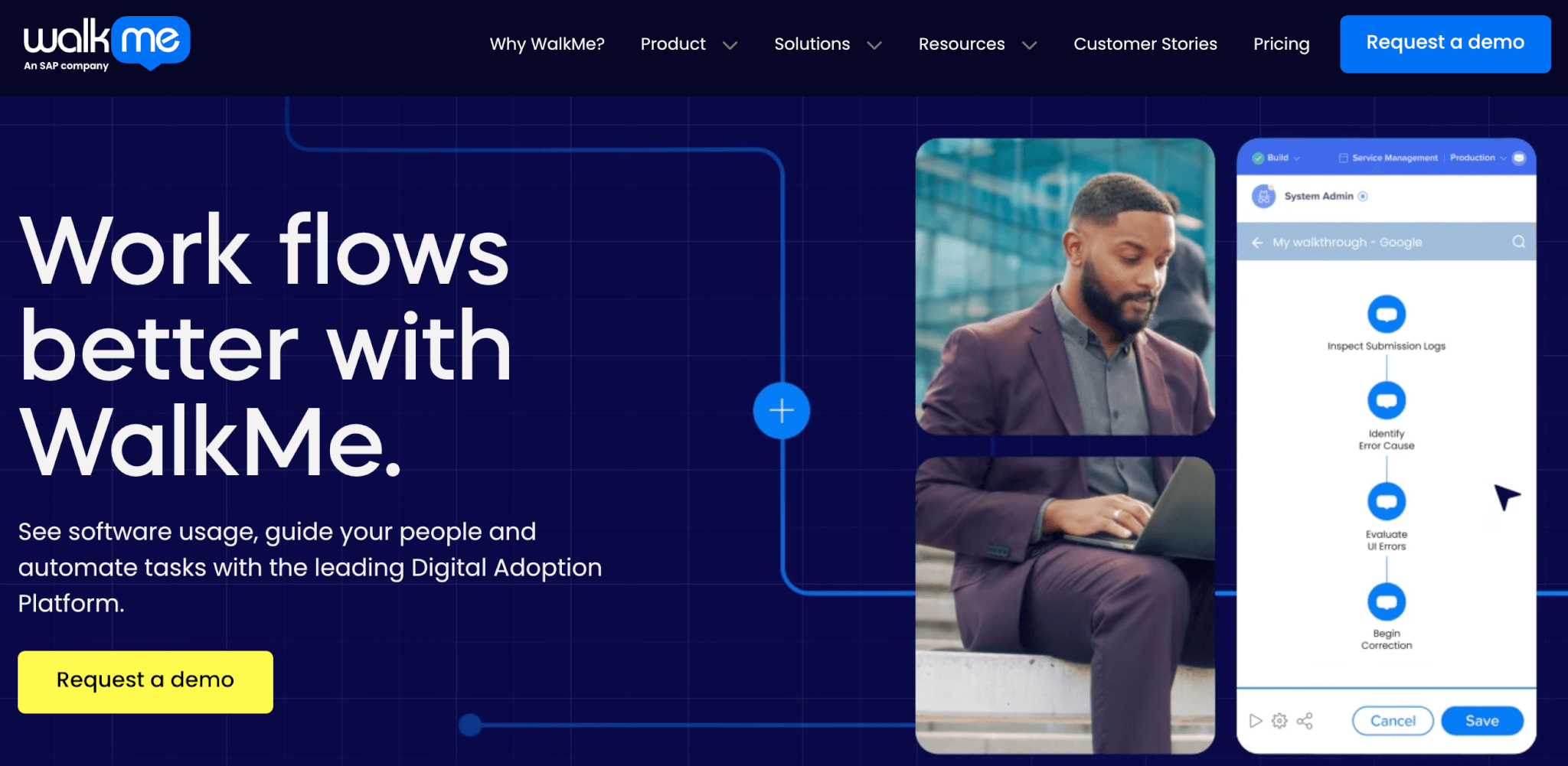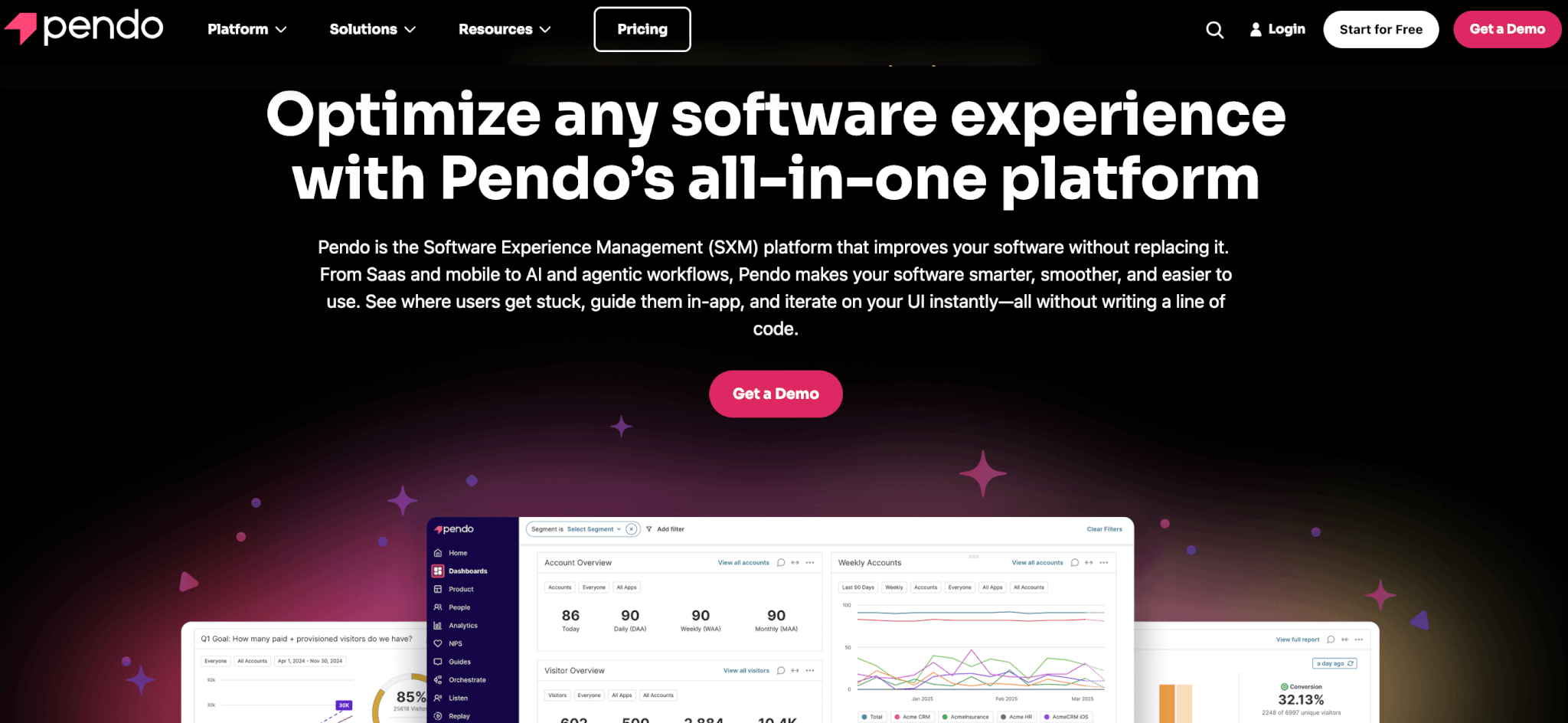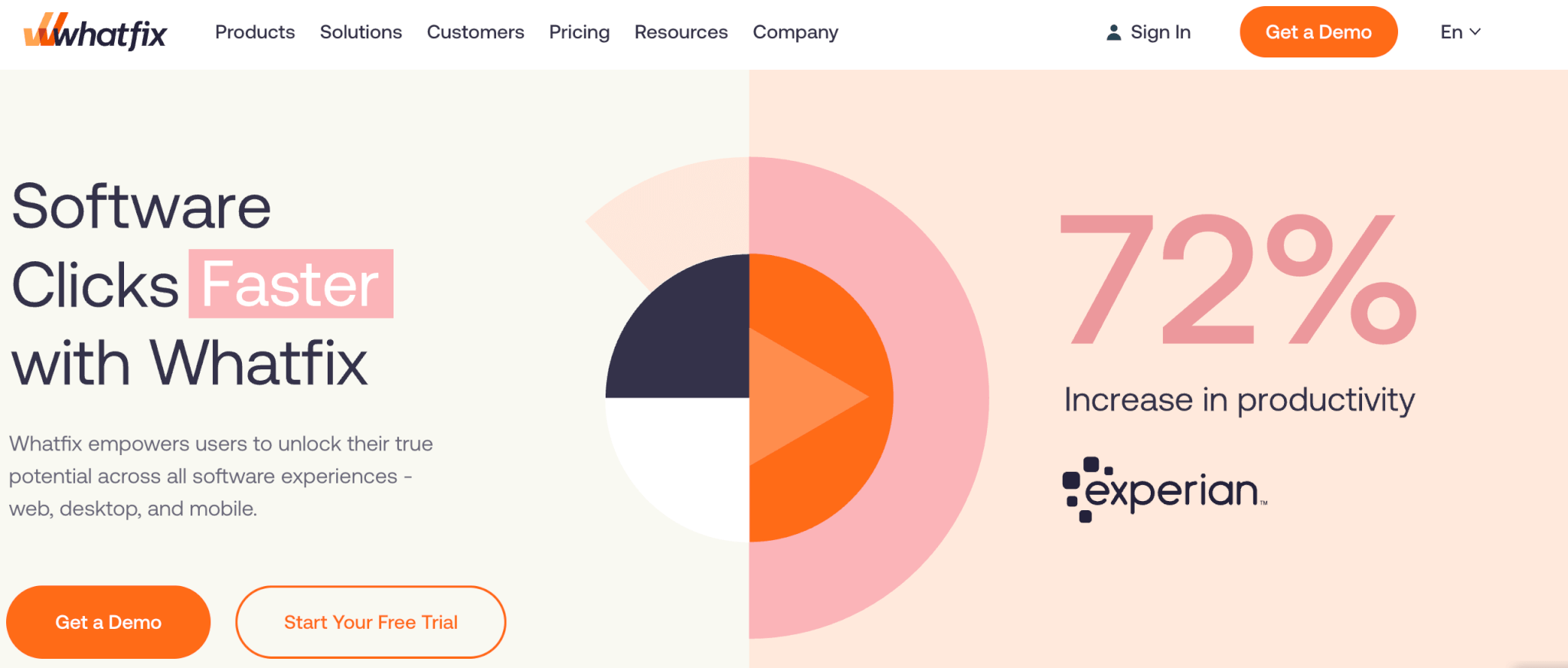Table of Contents
This is your one-stop guide to understanding digital adoption and successfully introducing new tools to the workplace. Whether your goal is successful digital adoption or a full-on digital transformation, we’ve got you covered.
Here’s what we’re discussing:
Defining digital adoption
Digital adoption is the process where users leverage digital tools to their fullest potential, getting the maximum value from them.
Digital adoption refers both to individual customers who buy a digital product for personal use, such as an app, and to employees who need to learn how to use new software introduced to their process.
The goal of customer-facing digital adoption is to improve user experience and proficiency. For employee-facing adoption, there are additional goals like boosting productivity and efficiency. In this blog post, we’re focusing on the latter, although many of the strategies and tools discussed can be applied to both cases.
Important questions to answer:
Are digital usage and adoption the same?
Absolutely not. Usage is barely touching the surface, and it’s often occasional and superficial. Digital adoption involves becoming proficient and deeply engaging with a digital product, using it regularly or even daily, and has a real impact on the user’s workflows.
How long does it typically take to achieve full digital adoption?
For this, we have reached out to professionals who have firsthand experience with digital adoption. Valentin Radu, CEO & Founder of Omnicovert, shares his view on the matter:
Achieving complete digital integration when rolling out a new platform usually hinges on several elements, often taking anywhere from 6 to 12 months. For smaller, nimble companies, adoption can occur more rapidly—sometimes within a few months—especially if the team is driven and the advantages are effectively conveyed. However, in larger corporations, the process might extend closer to a year due to the need for training sessions, alignment with current systems, and gaining internal support. One key factor I’ve observed is that the commitment of leadership to advocate for the platform significantly impacts the speed of adoption.
Valentin Radu, CEO & Founder, Blogger, Speaker, Podcaster, Omniconvert
What is the difference between digital adoption and digital transformation?
Digital adoption refers to getting users, be they employees or customers, to integrate digital technologies and tech tools into their lives.
Digital transformation is a more demanding, time-consuming, and impactful process that takes an average of 3 to 5 years to complete. It refers to an organization fully embracing digital technology to transform its daily operations and workflows.
In this context, digital adoption is part of the digital transformation process.
Why digital adoption matters
For a business, the benefits of digital adoption are substantial and go beyond fads.
Boosts productivity
New digital technologies offer fast and reliable solutions that improve employee productivity by automating tasks that take up valuable time from an employee’s workday, streamlining workflows, and reducing errors that demand reworking.
Positively impacts ROI
A recent report by WalkMe shows that “organizations mastering digital adoption best practices achieve an 85% ROI on their digital transformation investments.” This goes to show the deep impact of using digital tools in the workplace: faster turnaround times and fewer errors increase efficiency and boost profits.

Improves user experience
Provided you follow a structured digital adoption strategy that successfully educates employees, their user experience will significantly improve. Being able to explore the new tool with minimum friction, they will be able to make the most of it.
Helps improve your product
Digital adoption drives more digital adoption. When users have adopted your product, through product analytics and user feedback, you access eye-opening insights that help you improve your product to make it more relevant to your users’ needs.
7 key components of a digital adoption strategy
An intuitive product is a good basis for digital adoption success. But it’s not enough. Like we mentioned, true digital adoption is more than usage. So, how do you support users until they embrace your software solution?
The following digital adoption strategies can be really helpful:
1. Align with business objectives
Your digital adoption strategy should support the bigger picture. Start by understanding your company’s goals and ensure your adoption efforts help meet them. Whether it’s increasing internal efficiency, improving customer experience, or reducing training costs, tying digital tools to business outcomes makes your efforts more impactful.
2. Get leadership on board
Leadership buy-in can make or break digital adoption. Company leaders set the example, so when they support digital tools, the rest of the organization is more likely to follow through. Their endorsement prompts other teams to take the change seriously and start using the new software.
3. Plan for change management
Introducing new digital tools (like a CRM, ERP, or LMS) is more than a technical update. It’s a deep change that affects workflows and procedures, job descriptions, communication habits, and even company culture in the case of digital transformation.
Without a change management strategy, even the best technology can fail to gain traction because people aren’t ready or willing to use it. What you can do:
4. Offer in app guidance
Use a digital adoption platform (DAP) to provide a smooth user onboarding experience, offering help exactly when it’s needed without requiring users to leave the platform. In app guidance usually includes:
The usage of digital adoption tools is highly recommended since apart from fostering user adoption they also offer deep analytics into user behavior and product usability.
5. Provide continuous learning
Treat digital adoption as an ongoing process. Make sure there’s always a way for users to learn more as their needs evolve or when your goal is a complete digital transformation. When people know support is available, they’re more likely to explore and use new features. Some ways you can provide continuous support:
6. Track user adoption
To improve digital adoption, you need to understand how users interact with your product. Look at how often users engage with different features, where they drop off, and which parts of the product are underused. These insights help you spot what’s working, and what’s not.
7. Reiterate
Once you know where users struggle, you can take action by improving onboarding, simplifying workflows, or offering new help content. You might even need to consider simplifying some features and removing friction from the product’s UI. A good technology adoption strategy is always improving.
Common challenges and mistakes that hinder digital adoption
The following mistakes are common among companies that have embarked on a digital adoption journey.
Overwhelming users with multiple new tools
Rolling out too many new tools at once can backfire. When users are expected to learn different platforms, dashboards, and what-have-you, it creates confusion and frustration. Instead of improving productivity, it slows things down.
What you should do instead:
Focus on introducing tools gradually and only when there’s a clear need and value.
Neglecting ongoing training
An employee training program is important for new software utilization, but it’s not enough. Without ongoing training, users fall behind, lose sight of new features, and end up avoid using the tool altogether.
What you should do instead:
Make sure your training resources remain evergreen and readily available. Create knowledge bases, on-demand training courses, video tutorials, and keep the lines of support with your IT department open.
Focusing on vanity metrics over user behavior
Tracking sign-ups or logins might look good on paper, but they don’t tell the full story. True adoption is about how users interact with the product: what features they use, where they get stuck, and whether they’re achieving their goals.
What you should do instead:
Dig into behavioral data and signs of real engagement. Use this information to improve user onboarding and training resources.
How to measure digital adoption success
Are your digital adoption efforts paying off? Here are key metrics to measure digital adoption and ensure you’re on the right path.
Monitor usage and engagement
Search for patterns that show whether users are actively engaging and getting value from the platform. User engagement metrics will tell you if people are regularly logging in and interacting with your digital tools:
Track support queries
Monitoring support requests helps you understand how smoothly employees are adapting. A spike in help desk tickets might signal that users are struggling with the new technology. On the other hand, a steady drop indicates they have started to get a hold of it. Track not only the volume but also the common issues mentioned.
Evaluate employee productivity
One of the main goals of digital adoption is to help employees work more efficiently. You can measure productivity by comparing performance before and after implementation. Two things to keep in mind:
Collect employee feedback
Hearing directly from users helps you understand the impact and improve your digital transformation efforts.
3 top digital adoption platforms
Digital transformation success largely depends on the tools you use to facilitate technology adoption. Using a digital adoption platform will help you provide timely, contextual assistance to guide users through initial setup and beyond.
We have picked and reviewed some of the best digital adoption solutions for you:
WalkMe

WalkMe is an enterprise digital adoption platform designed to support businesses introducing complex software. It provides step-by-step, contextual guidance within apps on web, desktop, or mobile. The WalkMe Workstation allows employees to access, streamline, and manage their tasks from a single dashboard.
The platform’s AI-driven DeepUI technology recognizes changes in the software user interface and adjusts flows automatically. WalkMe also offers robust analytics to track user progress, showing how users interact with tools, where they get stuck, and which processes may need improvement. Its smart assistant and search tools make it easy for employees to find what they need and stay productive.
Key features
Pendo

Pendo is a Software Experience Management (SXM) platform built to improve user engagement and the way people experience your software. It allows you to track user behavior and trends and uses AI to summarize key insights. You can create segments, test different approaches, and coordinate messages both in-app and by email to keep users engaged.
It also offers AI-generated walkthroughs that you can place directly inside your product, giving users help right when they need it. With analytics, feedback collection, and user guidance all in one place, Pendo works well for teams that want a complete view of the user journey.
Key features
Whatfix

Whatfix is a digital adoption platform designed to guide users directly within applications. You can provide in app guidance through walkthroughs, a central help hub, and targeted messages that work across web, mobile, and desktop. With detailed analytics, teams can see where users drop off, which features get the most attention, and what support content is being searched.
The platform also uses AI to streamline tasks like content generation and workflow automation. A key idea behind Whatfix is “Userization,” which means shaping the experience around each user’s actions and needs. It’s a go-to solution for organizations working with complex software who want a scalable way to train and support employees.
Key features
Explore more in our blog 5 top product adoption software platforms to boost user engagement.
Conclusion
A successful digital adoption strategy helps businesses get the most out of the tools they invest in. If employees don’t use new software the right way, poor digital adoption can slow things down and waste time and money.
The best way to avoid this is to focus on supporting the people using the tools. Get managers actively involved, communicate the benefits, and offer continuous training. When employees feel confident and supported, they’re more likely to adapt faster and stick with the new tools.
Before you go, sign up for a 30-day free trial with LearnWorlds, the LMS that meets all your training needs from employee onboarding to customer education.

Androniki Koumadoraki
Androniki is a Content Writer at LearnWorlds sharing Instructional Design and marketing tips. With solid experience in B2B writing and technical translation, she is passionate about learning and spreading knowledge. She is also an aspiring yogi, a book nerd, and a talented transponster.

